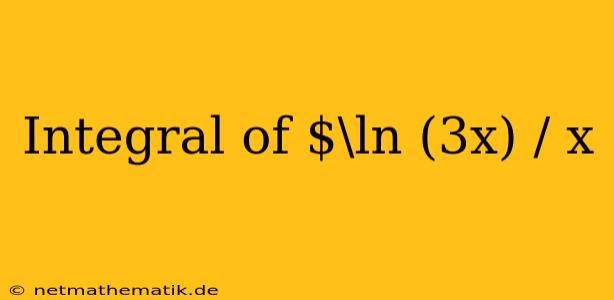The integral of $\ln(3x)/x$ is a fascinating example of how to apply integration by parts, a fundamental technique in calculus. While it might seem daunting at first, breaking down the problem into manageable steps and understanding the underlying principles will make the solution clear and intuitive. Let's delve into the process of evaluating this integral, exploring the nuances of integration by parts and highlighting key concepts along the way.
Understanding Integration by Parts
Integration by parts is a powerful tool for integrating products of functions. It stems from the product rule of differentiation and allows us to express the integral of a product in terms of the integral of a simpler function. Formally, the integration by parts formula states:
$\int u , dv = uv - \int v , du$
where $u$ and $v$ are differentiable functions of $x$. The essence of this formula lies in choosing appropriate functions for $u$ and $dv$ to make the right-hand side easier to integrate than the left-hand side.
Applying Integration by Parts to $\ln(3x)/x$
To solve the integral of $\ln(3x)/x$, we need to identify suitable functions for $u$ and $dv$ within our integrand. A good strategy is to choose $u$ as the function that becomes simpler when differentiated and $dv$ as the function that is readily integrable.
-
Choosing $u$ and $dv$:
Let's set:
- $u = \ln(3x)$
- $dv = \frac{1}{x} , dx$
-
Finding $du$ and $v$:
Differentiating $u$, we get:
- $du = \frac{1}{x} , dx$
Integrating $dv$, we obtain:
- $v = \ln(x)$
-
Applying the Formula:
Substituting these values into the integration by parts formula, we get:
$\int \frac{\ln(3x)}{x} , dx = \ln(3x) \ln(x) - \int \ln(x) \frac{1}{x} , dx$
Notice that the integral on the right-hand side now involves $\ln(x)/x$, a simpler integrand than the original.
-
Solving the Remaining Integral:
The remaining integral, $\int \ln(x) / x , dx$, can be solved using a similar application of integration by parts. We can set:
- $u = \ln(x)$
- $dv = \frac{1}{x} , dx$
Following the steps above, we find:
- $du = \frac{1}{x} , dx$
- $v = \ln(x)$
Applying the integration by parts formula again, we obtain:
$\int \frac{\ln(x)}{x} , dx = \ln(x) \ln(x) - \int \ln(x) \frac{1}{x} , dx$
This leads to:
$2 \int \frac{\ln(x)}{x} , dx = \ln^2(x)$
Therefore:
$\int \frac{\ln(x)}{x} , dx = \frac{1}{2} \ln^2(x) + C$
-
Substituting Back:
Finally, we substitute the result of the integral of $\ln(x)/x$ back into our initial equation:
$\int \frac{\ln(3x)}{x} , dx = \ln(3x) \ln(x) - \frac{1}{2} \ln^2(x) + C$
Conclusion
The integral of $\ln(3x)/x$ demonstrates the power and elegance of integration by parts. By carefully choosing our $u$ and $dv$, we were able to simplify the integrand and arrive at a solution. The process highlights the importance of understanding the fundamental principles of integration and choosing the right techniques to tackle different types of problems. Remember, practice is key, and with each integral you solve, you'll gain a deeper understanding and appreciation for the beauty of calculus.
